What is Underpinning?
Underpinning is a method used to repair and strengthen the foundation of a building. During underpinning, reinforcements are positioned throughout the length or breadth of an already established base. Because of this, its weight is distributed across a larger area and rests on solid earth layers. Micro-piling and jet grouting are common underlying methods, despite being time-consuming and costly.
Underpinning is excavating the soil that’s pulling away from the structure and eliminating the foundation holding it up. There will be movement in the building when the current foundations become weakened. The property’s foundations and structure are strengthened by installing new, more robust materials and digging deeper footings on top of the more stable growth.
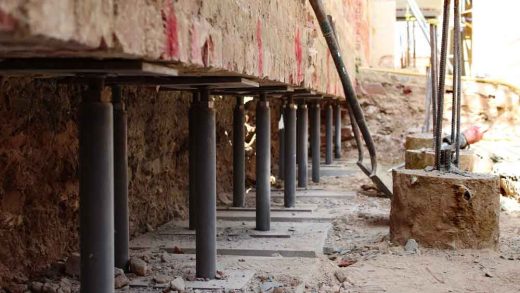
Fig 1: Underpinning Method
Courtesy: structural guide.com
The Necessity of Underpinning the Foundation:
By observing, you can figure out what kind of foundation is needed. When a structure changes due to settlement or other damage, take vertical and offset measurements as quickly as possible. It depends on how bad the settlement is on how long it takes. Before starting to dig for a new project, experts have to take a close look at the soil to see how well it can support the structure that will be built on top of it. This report decides if underpinning is needed. Sometimes, these tests would show that the building didn’t need underpinning.
Selection of Underpinning Methods:
Underpinning methods are chosen based on the age of the building and the kinds of work it has. Depending on how old a building is, it is classified as:
i) Ancient structures are older than 150 years.
ii) Recent Structures: Ages between 50 and 150 years.
iii) Modern Structures: Ages under 50 years.
Types of Works for Underpinning Methods Selection:
i) Conversion Works:
The building needs to be changed so it can be used for a different purpose, which means the foundation needs to be made stronger than it is now.
ii) Protection Works:
The following issues with a building require protective measures:
- The current foundation is neither solid nor reliable.
- As a result of nearby excavation, the soil supporting the current footing would be compromised.
- Soil stabilization for protection against earthquakes, floods, and other disasters
- Need for an underground space below an existing building
iii) Remedial Works:
- The structure sank due to errors in the initial foundation design.
- Instead of constructing a new structure, improve the one you have.
Structural Conditions which Require Underpinning:
As a substructure stabilizing strategy, underpinning is often recommended by engineers for a variety of reasons such as:
- Traditional buildings that rest on wood piles will eventually sink due to the piles’ deterioration. This destruction of buildings is due to shifts in the groundwater level.
- An unstable soil structure can lead to structural damage in buildings when the water table rises and falls.
- The structure’s weight will settle for buildings constructed on unstable ground.
Methods of Underpinning Foundation:
1. Pit Method or Mass Concrete Underpinning Method:
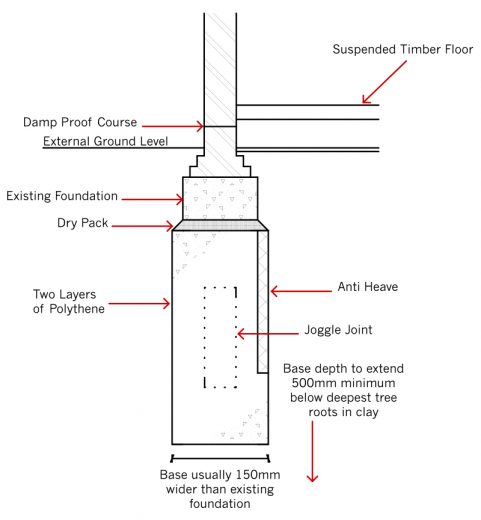
Fig 2: Pit Method of Underpinning
Courtesy: falconstructural.co.uk
Pit or mass concrete underpinning is one of the earliest techniques. Procedures are carried out to increase the size of the present foundation until a stable layer is attained. Stages or pegs are used to reveal the soil beneath the current foundation. After the desired layers have been reached, the excavation is backfilled with concrete and left to dry before the next removal process can begin.
Adding a dry sand-cement pack as a second linchpin helps shift the weight from the old to the new base. This simple method is effective due to the light foundation. Better options exist to address more intricate issues at the ground level.
2. Pile Method of Underpinning:
The driving technique is utilized to install piles as part of the piling method for underpinning a foundation. Driving piles are placed on either side of the wall to strengthen it. The borehole is normally supported by piles that have been under-reamed. Steel or concrete “needles” are regularly driven into the wall and connected to the foundation piles. These metal or cement piles serve as a support structure and a pile cap. Water-logged soils, clay, and shaky bearing stratum are ideal conditions for installing underpinning piles.
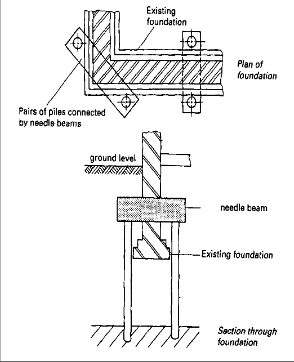
Fig 3: Pile Method of Underpinning
Courtesy: anbeal.co.uk
3. Jack Pile Method of Underpinning:
When the cost of traditional underpinning would be prohibitive due to the depth of good bearing capacity subsoil, Jack Pile Underpinning is an option. As the pile depth may be adjusted to suit the underlying soil, jack pile underpinning is silent, vibration-free, and adaptable. Since the pile caps are cast directly onto the jack pile heads once the hydraulic jacks have been removed, the condition of the existing foundations is critical.
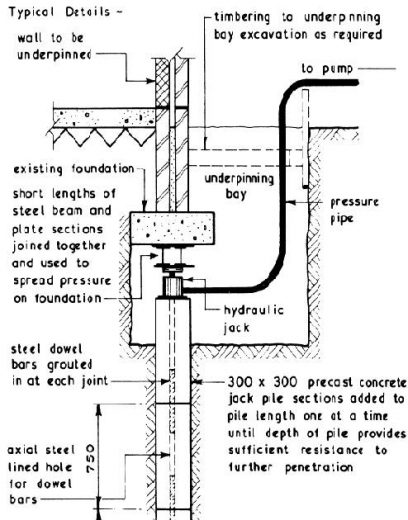
Fig 4: Jack Pile Method of Underpinning
Courtesy: civil-eng-blog.worldspot.com
4. Root Pile or Angle Piling For Underpinning:
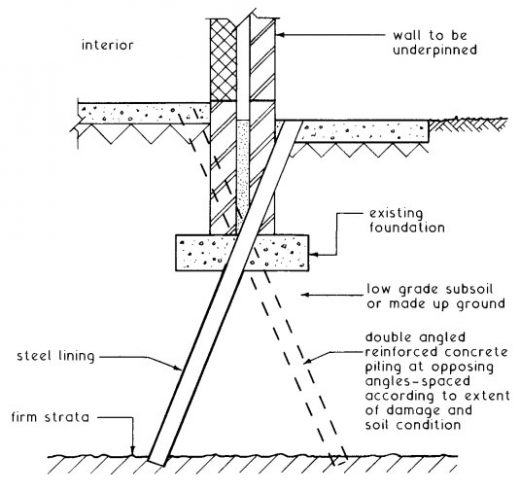
Fig 5: Angle Pile Method of Underpinning
Courtesy: buildersengineer.info
The Root or Angle piling method utilizes cutting-edge concrete drilling technologies to produce concrete, reducing building expenses and time. Line Pairs of reinforced concrete piles are often installed or driven at right angles to one another. Predrilling using an air-flushed percussion drill reinforces the brick wall without disturbing the subfloor. It might be challenging to install angle piling inside a wall. As a result, they are stacked closely together to ensure their stability.
5. Pynford Stool Method for Underpinning:
When the current foundations are in poor form, this method can be employed to underpin the wall in one continuous run without using needles or shoring. The resulting reinforced concrete beam could be sufficient to distribute the weight of the existing wall, or it could be used in conjunction with other underpinning techniques, such as regular piles or jack piles.
6. Underpinning Columns:
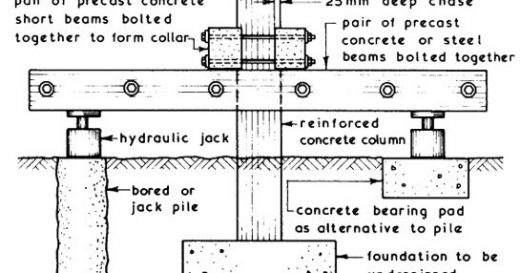
Fig 5: Underpinning Columns
Courtesy: buildersengineer.info
Once the columns’ loads have been removed, they can be supported in the same way as walls are—with conventional or jack piles. When dead beaches are used, beam loads are taken off the columns, and the real column weight is transferred by two beams resting on a collar at the base of the column shaft.
Advantages of Underpinning:
- Underpinning is good because it strengthens the foundation and protects it from all kinds of disasters.
- With underpinning, you can get more light into your building. You add new rooms or offices to your building and add more windows and doors so that natural light can get in.
- By underpinning your basement, you can get to your home’s plumbing, insulation, and wiring to see if they need to be fixed.
- One great thing about underpinning is that it raises the value of your home. If you want to sell your home in the future, it will be worth more and give you a good return if it is well-built and has finished underpinning.
- Underpinning is a great way to add more space to a structure in a way that costs less and causes less trouble. Buying a new house could be expensive if you want more space, but underpinning can save you that money. Also, you won’t have to pay for expensive repairs down the road.
Disadvantages of Underpinning:
- The nature of the underlying foundation method is expansive.
- When unstable and flooded ground, it is exceedingly challenging to underpin buildings.
- On the working site, a significant volume of excavated material is dumped during excavation.
Conclusion:
Underpinning is a technique used to reinforce and restore the foundation of a building. By underpinning, existing buildings and infrastructures can have their weak foundations strengthened. One such method is adding permanent or temporary support to an existing base to increase its depth and load capacity.
References:
1. Discoveries, Engineering. “What Is Underpinning? Uses In Foundation Strengthening and Methods – Engineering Discoveries.” Engineering Discoveries, 1 Aug. 2021, engineeringdiscoveries.com/what-is-underpinning-uses-in-foundation-strengthening-and-methods.
2. CementConcrete. “Underpinning Methods, Procedure, Use in Foundation Strengthening and Repair – Cement Concrete.” Cement Concrete, 22 Mar. 2020, cementconcrete.org/buildings/underpinning-methods-procedure-foundation-strengthening-repair/2092.
3. “Underpinning – Wikipedia.” Underpinning – Wikipedia, 1 Jan. 2012, en.wikipedia.org/wiki/Underpinning.
4. Boss, kumaresh. “(PDF) SHORING AND UNDERPINNING | Kumaresh Boss – Academia.Edu.” (PDF) SHORING AND UNDERPINNING | Kumaresh Boss – Academia.Edu, www.academia.edu/40161849/SHORING_AND_UNDERPINNING. Accessed 26 Sept. 2022..
5. Projects, Engineering. “Underpinning | Underpinning Methods and Purpose.” Engineering Projects, 17 Oct. 2013, bestengineeringprojects.com/underpinning-method-of-underpinning-pit-method-pile-method.
6. LCETED. “WHAT IS UNDERPINNING | USES OF UNDERPINNING | METHODS OF UNDERPINNING | PRECAUTIONARY MEASURES -Lceted LCETED INSTITUTE FOR CIVIL ENGINEERS.” LCETED INSTITUTE FOR CIVIL ENGINEERS, 2 Sept. 2001, www.lceted.com/2021/09/what-is-underpinning.html.
If you have a query, you can ask a question here.


